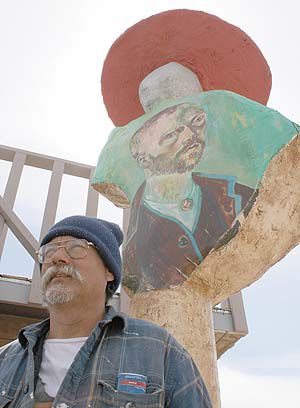| Wayne Stevens stands beneath one of his many yard scuptures, with a painting of Vincent Van Gogh on the side of it. |
There are a lot of sites to see for travelers who motor down U.S. 6, a road that crosses America starting in Cape Cod, Mass. and ends in Long Beach, Calif. There are oceans to see, plains to cross, mountains to traverse, red rock to brighten up the ride, the loneliest stretch of road in America and then the Pacific Ocean. The sites are tremendous and sometimes unusual.
One of those unusual sites lays just east of Wellington, along the north side of the road, where Wayne “Stev” Stevens has put together a palace of art that adorns the roadside, the inside of his home and the entire yard. Standing on the busy highway, one can see drivers looking at the yard as they drive by trying to figure out what is going up on the east border of the property.
“It’s a barbecue,” says Stevens, who also goes by the nickname Bear Paw. “I am building it so we can have a barbecue any time of year.”
The concrete pillared structure looks much like a kids playhouse with an observation deck on the top, but Stevens insists it will be a great gathering point for the “nearby neighbors that have been so good to him” since he arrived in the area a few years ago from Florida.
“I had been driving all over the United States just to find a place where I wanted to settle and I was driving through here on my way to Wyoming, where I thought I would end up,” he said as he put a couple of nails into the structure under construction. “But when I came here, there was this house and the price was right so I decided to stay.”
Stevens converted the nearby metal garage into a workshop for his art and began to paint in a studio he put together in the basement. As one walks through the yard and then into the house, one gets the feeling that he has tried every kind of medium artists use, but the pattern of the creations leads to the idea that Stevens knows where he’s going.
“I always have been an artist and for the last 30 years I have been led toward Fractal art,” said Stevens as he showed off his indoor art gallery that also serves as the front room of his home. Remodeled with wood floors and Indian patterned counter tops the entire floor takes on the feel of a gallery that appreciates what is hanging on the wall.
| A partially finished portrait of a woman from Arizona Stevens took a photo of. |
“Fractal Art displays patterns of chaos; it looks beneath the skin of creatures and shows their insides,” says Stevens. “It involves the flow of life.”
Born in New York near Niagara Falls, Stevens came from an artistic family that drew their images from his Irish background and Native American ancestry. He says while Fractal Art is his main emphasis, he has practiced in five different movements of the art world.
“Fractal Art was the kind of art Jackson Pollack approached through the back door,” said Stevens. ” I think I am going at it through the front door.”
Stevens has a portrait of a woman he met in Arizona on his easel downstairs. The painting isn’t finished but he sees great lines in her face and a very interesting nose.
“Don’t you think she almost looks like she comes from Aztec ancestry?” he asked as he looked at the photo he took of her.
| There is a veritable gallery of Fractal Art within Stevens’ home in Wellington. |
He also says that Fractal Art allows an artist to look at famous works of art and turn them into something a little different. A painting he has done of the Mona Lisa near where the girl’s image resides, and it has a whole different feel than the original.
“Fractal Art allows the mood of the people in the paintings to fit in with the surroundings,” said Stevens. “I think it is how the scientific world sees it.”
An image in Stevens’ front room gallery shows a group of gorillas posing. Stevens created the image from a photo and it is an example of Fractal Art. It is what can be seen through the skin of a creature; the veins, arteries and nerves.
“That image came from National Geographic,” said Stevens. “They are a family of gorillas that Dian Fossey worked with. It was terrible what happened to her.”
Stevens loves living by US 6; people stop and look at his art, and talk to him since he does a lot of his work outside for all to see.
“Many just want directions and I help them out,” he says as he looked out at the street.
Stevens hopes that someday, his metal workshop will be the first art gallery in Wellington; a place where people can see his work.
For now, however, he works in many mediums, right in the yard, for everyone who passes on that coast to coast highway, to see.

